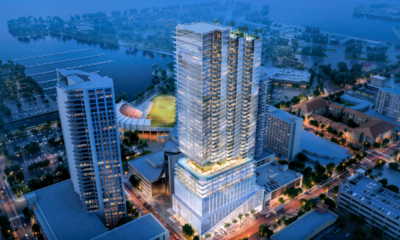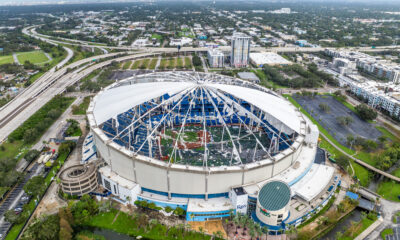Rays stadium resiliency takes center stage

Ensuring environmental resiliency throughout the St. Petersburg peninsula is paramount as temperatures increase, sea levels rise and storms become more frequent and intense. It is also a focal point of the largest redevelopment project in the city’s history.
City council members, administrators and the Tampa Bay Rays/Hines development team discussed the topic early and often at a June 12 stadium redevelopment workshop. Tropicana Field provides an emergency shelter and Duke Energy staging area during natural disasters, although officials have yet to open it for evacuated residents.
If approved, the Rays would demolish the Trop and build a new $1.37 billion ballpark. City council members want to ensure the facility meets environmental resiliency standards before offering their votes, tentatively set for July 11.
The new stadium will anchor the Historic Gas Plant District’s $6.5 billion redevelopment, and the city would subsidize about 21% of the generational project’s costs. After the meeting, Mayor Ken Welch said the public-private partnership would continue incorporating the council’s feedback, including its desire to incorporate the world’s most widely used green building rating system.
“Like the LEED (Leadership in Energy and Environmental Design) issue,” Welch told the Catalyst. “That’s something that I think is reasonable. We’re going to build to that standard, anyway, why not make that more explicit?”
Councilmember Brandi Gabbard was the first to broach stadium sustainability. She questioned why that wasn’t a prominent topic during agreement presentations.
The ballpark would feature extensive glass paneling, and Gabbard asked for its storm rating. Byron Chambers, senior principal for stadium design firm Populous, said the glazing could withstand a Category 4 hurricane with maximum sustained winds between 130 and 156 mph.
Zach Allee, senior architect for Populous, said the project would include solar arrays and backup generators. However, he could not provide additional details as the schematic design process is ongoing.
Populous also helped create Seattle’s Climate Pledge Arena, widely recognized for its resiliency aspects. Chambers believes it received LEED Gold status, the second highest of four tiers. According to the U.S. Green Building Council, LEED certification “provides a framework for healthy, highly efficient and cost-saving green buildings, which offer environmental, social and governance benefits.”
Gabbard was the first of several council members to request a LEED mandate in the development agreements. She called the impending vote a philosophical question of whether the potential city asset warrants a $287.5 million public subsidy with a $683.8 million debt service estimate.
“I’m there when it comes to economic opportunity,” Gabbard added. “I’m there with keeping the history of baseball. I’m there with keeping the promises that need to be kept – to your point, mayor. I’m not there when it comes to this particular piece of it.”
Councilmember Richie Floyd questioned why operating agreements did not mention shelter uses. Administrator Rob Gerdes said the new ballpark could “absolutely” provide refuge for first responders and displaced residents.
Amy Foster, neighborhood services administrator, provided recent statistics that showed the city and county have “significantly more shelter space than is needed.” At a recent event, Duke President Melissa Seixas told the Catalyst that the company has a portfolio of staging areas it can utilize during stadium construction.

An electric contractor’s bucket truck provided an aerial view of Duke Florida’s expansive Tropicana Field staging site ahead of Hurricane Idalia in August 2023. Photo by Mark Parker.
Chambers said the ballpark “would be responsive” to St. Petersburg’s needs. He called the site resilient and ideal for urban infill projects. He also noted its connection to the Pinellas Trail increases accessibility.
“We will be delivering a relatively low-carbon ballpark,” Chambers added. “All of our systems are designed to reduce consumption of energy and operate as efficiently as possible.”
He explained that the operable glass walls increase ventilation and provide natural lighting. The development team pledged to explore a “host of energy conservation features” and responsibly source building materials.
Chambers said the developers are studying local sea level rise and discerning stormwater management opportunities. He expects to capture and repurpose three million gallons annually – a “big thing.”
Chambers noted they are already testing Booker Creek to establish a water quality baseline. Plans for the revitalized urban stream include new native vegetation, pocket parks, an educational boardwalk and stormwater gardens.
The Rays/Hines would also implement flood mitigation systems, create biological habitats and continuously clean the creek water as it passes through the site. The city would still use it as a stormwater conveyance.

A diagram highlighting various features around a restored Booker Creek.
State preemption prevents the city from mandating electric vehicle charging stations. However, the project will feature several, and Gabbard said it is “a whole lot cheaper for you to do it now than to retrofit it later, and the need is only going to get greater.”
Nearly every council member expressed support for mandating a LEED certification. They will discuss agreement revisions July 9.
“I’m trying to think into the future, and if, God forbid, the worst happens, we will need to use this facility in some way, shape or form to make our city whole,” Gabbard said. “I don’t want us to then have a facility we have to use that is not adequate, or maybe not even usable, because it wasn’t built the way it needs to be built.”








S. Rose Smith-Hayes
June 18, 2024at7:52 pm
How much return will the City receive in profits??????????
Stafford, Maureen
June 18, 2024at5:38 pm
There are none so blind as the five who will not see. What is it that mitigates any of the red flags in this absurd deal/giveaway?
Could it be that the five are unable to sagaciously assimilate all, or enough, of the details in such a short time to say “hold on, let’s slow this thing down”, or is there another reason I don’t want to hear for their rush to approve it? There is a simple out for them: Put it to a referendum. Let the people decide their own fate. After all, we are the ones who will have to face the mess if we can’t pay the bills the great deal will deal us!
Tom Tito
June 18, 2024at4:32 pm
we are paying $2.4 Billion and 5 council members think they need to beg for community benefits and voted without insisting that this is in the contract.
BK
June 18, 2024at4:24 pm
How city leaders justify putting a single dime into a $1.3 billion stadium for the benefit of a billionaire who could easily finance the whole project privately just blows my mind.
Maria Callas
June 18, 2024at8:42 am
I think we have new ballpark for the Rays.
Alan DeLisle
June 18, 2024at7:02 am
This deal is not salvageable, no matter the games played at the end by the Rays, Welch and the “sold out Five.” Every city in the country is laughing at St Pete over how bad this deal is.
And what is sad is that the “sold out Five” have chosen the Rays over their city. The Rays will now “control” St Pete if this deal goes through. If the “sold out five” can’t acknowledged how bad this deal is then they have abandoned the taxpayers and voters for a Wall St billionaire. Remember the “sold out Five.” And remember the “trustworthy three!”
A majority of voters oppose the deal. St Pete needs courage from its business community and its leaders. Regret lasts for a long time.
Ryan Todd
June 17, 2024at10:09 pm
Let’s litigate the hell out of this thing if it passes and hold-it-up in court long enough to recall Ken Welch and the five council members voting to support the deal.
Karyn Mueller, PE
June 17, 2024at8:03 pm
It’s so obvious they’re going to pretend they improved the deal by requiring LEED certification at the end. Everyone already knows this is the play.
They held back the community benefits the CBAC unanimously voted on and then they add them back in at the end. Between the vertical construction requiring 15% apprenticeships, disadvantaged businesses/workers and MBE/DBE requirements, they refused initially but have since included it.
These are all standard things for any city project with public investment and LEED silver is Hines standard on their projects.
It’s a joke if Rays/Hines pretends they improved the terms of the original deal by meeting basic standards (after refusing to previously)
Jazz Thomas
June 17, 2024at2:12 pm
The only green part of this deal is the taxpayer money the City is giving to the Rays. Wake up St Pete.